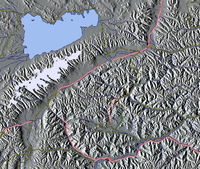
Photo from wikipedia
Abstract A new polyconitid rudist Shajia tibetica gen. et sp. nov., of late Aptian to Albian age, is described from the Langshan Formation of Nyima County, northern Lhasa Block, Tibet.… Click to show full abstract
Abstract A new polyconitid rudist Shajia tibetica gen. et sp. nov., of late Aptian to Albian age, is described from the Langshan Formation of Nyima County, northern Lhasa Block, Tibet. Though comparable in size and external morphology with Horiopleura haydeni Douville, which is a common endemic species in southwestern Asia, Shajia differs from the latter species in its possession of an inwardly inclined, instead of outwardly facing, posterior myophore in the right valve. In addition, a single specimen from Ladakh, which was previously assigned to Polyconites? sp., on account of a similar myophoral distinction from H. haydeni, is transferred to the new genus. Shajia is considered most likely to have been derived from one of a group of Horiopleura species that lived on the southern margin of the Mediterranean Tethys. The so-called ‘Yasin fauna’ represented by the late Aptian to Albian Horiopleura haydeni/Auroradiolites gilgitensis rudist association, is considered to be restricted to southwestern Asia, including Afghanistan, Kohistan in northern Pakistan and Ladakh in northern India, though those two species in particular have not so far been recorded from the Lhasa Block of Tibet. Nevertheless, S. tibetica co-occurs with Auroradiolites biconvexus (Yang et al.), which probably evolved directly from A. gilgitensis (Douville), and the age of the latter association is in accordance with the generally accepted age of the Yasin fauna as late Aptian to Albian. Hence the S. tibetica and A. biconvexus association can be considered a regional variant of the Yasin fauna, which had evidently already dispersed to the Lhasa Block by the late Aptian. So the Langshan Formation can be considered palaeogeographically linked with other mid-Cretaceous shallow-marine carbonate deposits in adjacent southwestern Asian regions. These findings also provide new evidence that the age of the rudist assemblage of the Lhasa Block is late Aptian to Albian, although a slightly younger age cannot be excluded.
Journal Title: Cretaceous Research
Year Published: 2020
Link to full text (if available)
Share on Social Media: Sign Up to like & get
recommendations!